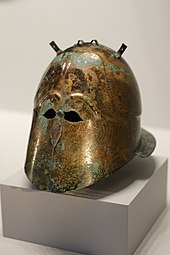Corinthian helmet
It was a helmet made of bronze which in its later styles covered the entire head and neck, with slits for the eyes and mouth.
This practice gave rise to a series of variant forms in Italy, where the slits were almost closed, since the helmet was no longer pulled over the face but worn cap-like.
Numerous examples of Corinthian helmets have been excavated,[1][2][3][4] and they are frequently depicted on ancient Greek pottery.
[citation needed] Herodotus mentions the Corinthian helmet in his Histories when writing of the Machlyes and Auseans, two tribes living along the River Triton in ancient Libya (the portion of ancient Libya he describes is most likely in modern Tunisia).
The tribes chose annually two teams of the fairest maidens who fought each other with sticks and stones.


